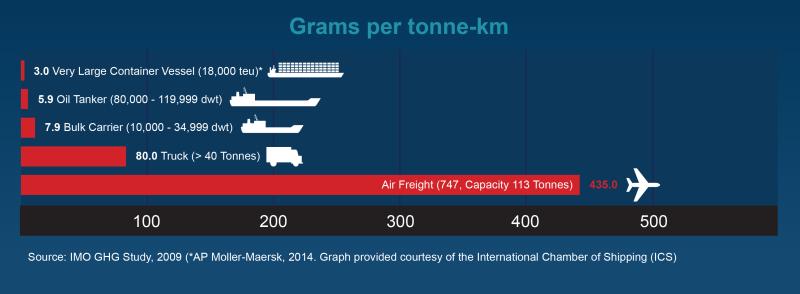
We recently posted “No, 15 Large Ships Do Not Pollute More Than All the Cars in the World.” It was based on a claim made by Dr. James Corbett in 2009, that only addressed sulfur pollution. Enthusiastic journalists picked up on the catchy claim and said that 15 large ships create more total pollution than all the cars in the world. The problem with that assertion is that Corbett’s rough calculation did not, among other things, include the trillion-tonne gorilla in the room, the carbon footprint of cars vs ships. Cars actually produce far more greenhouse gases than ships.
The challenge is figuring out how to compare cars and ships. A ship carries cargo, lots and lots of cargo, while most cars carry a few passengers at best. So rather than compare ships and cars directly, we will look at ships and trucks. Trucks are not cars, but they are similar and are actually more energy-efficient than cars, in terms of what they can carry. So, what are the comparative carbon footprints of each considering how much cargo they carry across a distance?
Depending on who runs the numbers, the results may vary slightly, but they all tell the same story. Ships have the lowest carbon footprint of any form of transportation by a huge margin.
Using an IMO Green House Gas study from 2009, graphically shown above, a large container ship creates 3 grams of carbon for every tonne of cargo carried for one kilometer. A large truck, by comparison, creates 80 grams of carbon from CO2, on the same basis. A ship has roughly a 26 times smaller carbon footprint than a heavy truck for every tonne of cargo carried.
The difference gets truly massive when comparing a container ship to a cargo-carrying airplane, which creates 436 grams of carbon per tonne-km, or roughly a 145 times larger carbon footprint than a container ship.
So, it is safe to say that shipping has the lowest carbon footprint of any form of transportation, but is that the end of the story? Unfortunately, no. Even if each individual ship has the lowest carbon footprint, taken together the amount of CO2 generated by the world fleet is massive. Shipping does, after all, carry 90% of the world’s trade and accounts for between 2-3% of carbon emissions globally. If global shipping were a country, it would have roughly the same carbon footprint as Germany.
Despite occasional media claims to the contrary, the shipping industry is not sitting back and saying “Well, 2-3% is not so much.” The International Maritime Organization (IMO) has mandated that shipping’s total carbon emissions will be cut by 50% as compared to 2008 levels. The world’s largest container shipping companies, including Maersk, CAM CGM, and MSC, have pledged to reach 100% carbon neutrality by 2050.
The cost to decarbonize shipping will be substantial. A recent analysis suggests that the cumulative investment needed between 2030 and 2050 to halve shipping’s emissions amounts to approximately $1-1.4 trillion or an average of $50-70 billion annually for 20 years. If shipping is to fully decarbonize by 2050, this will require further investments of some $400 billion over 20 years, bringing the total to $1.4-1.9 trillion.

I seem to have read that rail transport is the champion of efficiency.
But maritime: not too shabby!
Thankyou for this Rick.
While I no longer turn commercial miles, it is nice to know.
Doug,
Trains are great where ships cannot go but have roughly three times the carbon footprint per tonne-mile than ships. Trains are much more efficient than trucks and cars.
The greatest efficiency gains have come from ships: Triple expansion steam engines, steam turbine propulsion RACER, Rankine Cycle Energy Recovery..All of these technologies have been embraced, and used in land based applications…